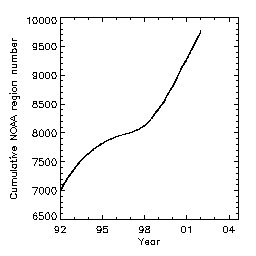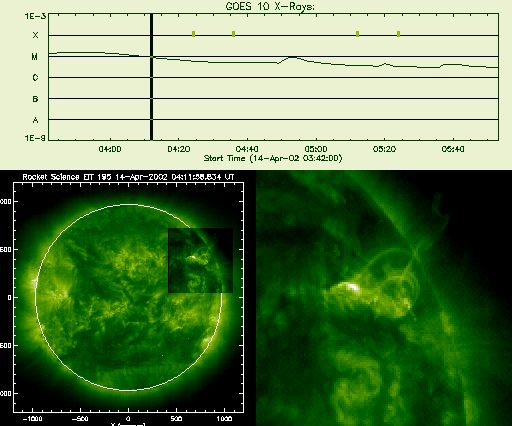Weekly Notes from the Yohkoh Soft X-Ray Telescope
(Week 15, 2002)
Science Nugget: April 12, 2002
Homologous jets
Introduction
X-ray jets, one of Yohkoh's truly new discoveries, have often featured in
Yohkoh science nuggets.
See the category "jet" in the
nugget topical index
for example.
Reviewing these past nuggets, it seems as though much of the important new
morphology has not been published yet.
But we have not done a nugget on homologous jets, i.e. repetitive
similar ones.
This is an obvious feature in the Yohkoh movie, where one can see
jet-prolific active regions appear from time to time.
The jets appear most frequently at the leading edge of the leading polarity
(following the description of
Hale)
of the sunspot group.
It is of course not so clear why this should be true, in case any
theoretical solar physicists are tuned in here.
SOHO views in NOAA region 9901
First a digression - sunspots occur in groups, and the one we are interested
in is number 9901.
Sunspot groups have lifetimes which range from a few to many weeks, but the
typical lifetime of a group is comparable to the
solar rotation period. This could possibly be the result of a fundamental
causal relationship, or simply one of the weird coincidences that one often
meets in Nature (such as the coincidence in angular sizes of Sun and Moon).
The higher the solar activity, the more regions, hence the NOAA region
numbers integrate the cyclic variation of sunspot numbers.
One can see this in the plot below:

The main thing about this curve is the inflection at solar minimum,
about 1996.
This marks the minimum of the sunspot cycle, when the rate of creation
of active regions dwindled.
Less magnetic flux emergence on the Sun: fewer NOAA active regions.
Fans of these nuggets will appreciate that this curve is S-shaped
(ie, a sigmoid), but of course if we extended it for a century
it would look more like a staircase.
The jets
In the absence of Yohkoh data we are not blind.
SOHO and TRACE, and now
RHESSI, are in orbit imaging the Sun.
TRACE
in particular is good for jet observations because of its high resolution.
Here is one of the several homologous events that occurred in NOAA region
9100, this one at 04:11 UT on April 11, 2002:
 The jet is the diagonal structure originating near frame center in the
lower-right image, appearing
to thread through the large magnetic loops comprising the coronal part of
region 9100.
Or, at least, that part visible at the particular EUV wavelength of this
image.
This and the other jets can be observed as
movies,
in this format (upper plot, the GOES soft X-ray time history; lower left,
the SOHO/EIT full-Sun view; lower right, the TRACE high-resolution image.)
The jet is the diagonal structure originating near frame center in the
lower-right image, appearing
to thread through the large magnetic loops comprising the coronal part of
region 9100.
Or, at least, that part visible at the particular EUV wavelength of this
image.
This and the other jets can be observed as
movies,
in this format (upper plot, the GOES soft X-ray time history; lower left,
the SOHO/EIT full-Sun view; lower right, the TRACE high-resolution image.)
Conclusions
Again, it's the behavior of the solar magnetic field that fascinates us the
most here.
The jet, a linear structure with an impulsive injection of hot material
(note that the image is monochromatic and hence roughly isothermal,
so that material heating
or cooling can fool the eye by appearing or disappearing magically),
strongly suggests the existence of open magnetic field lines, namely
fields that reach out and become a part of the solar wind.
Yet the image seems to show clearly that right next to this open field
structure, there are more normal closed field lines constituting the
coronal structure of the active region.
What remarkable distribution of coronal electric currents can make such a
complex structure, and what creates them?
The most important feature of this nugget, though, is where the information
came from.
If you are an expert and would like to do research, or just want to keep up
with developments, we are now keeping Web pages with
the latest solar events.
They have many movies with fascinating developments, including these.
[Topical
index] -o- [Chronological
index]
April 12, 2002
S. Freeland (freeland@sag.lmsal.com)
H. Hudson (hudson@sag.lmsal.com)


